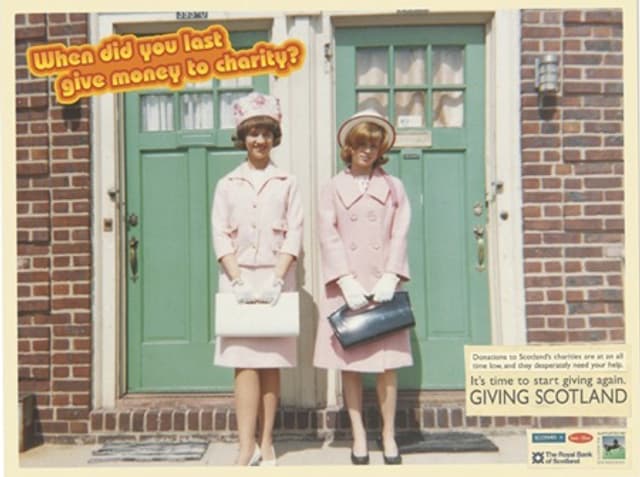Giving Scotland: crisis campaign
- Exhibited by
- Fiona Duncan.
- Added
- June 11, 2014
- Medium of Communication
- Broadcast and television, press advertising
- Target Audience
- Awareness
- Type of Charity
- Country of Origin
- Scotland
- Date of first appearance
- December, 2003
SOFII’s view
What do you do when there’s a scandal, or even several, and public opinion starts to run against you? Keep your head down and hope it’ll all blow over? Or do you make a bold stand to explain what you do and show its true value? The Giving Scotland campaign was launched in the face of intense scrutiny of charities in Scotland and critical analysis of charity practices, which were having a very negative impact on giving in the country. But this courageous campaign changed everything.
Creator / originator
Fiona Duncan.
Summary / objectives
To establish a charitable coalition of leaders in Scotland’s voluntary, representative of its scale and diversity, which would work together to make best use of contacts and collective leverage to raise funds over the festive period to:
- Engage the media and make them understand the impact of the sector on all aspects of Scottish life. To reverse the media attacks and secure positive coverage.
- Run an advertising campaign that would capture the imagination of the public and in itself create a story.
- Involve decision makers and MSPs and move legislative reform forward
The overall aim was to rebuild public confidence in the charitable sector in Scotland.
Background
The charitable sector in Scotland was experiencing an enormous amount of negative media coverage as a result of a number of ‘fundraising scandals’ and weak legislation. The first was in May 2003 when a commercial fundraising organisation’s bank accounts were frozen because the money it had raised (£8 million) had not been passed onto the relevant charity. This was swiftly followed by two further scandals. Then journalists took every opportunity to condemn and undermine the sector. By December, a poll commissioned by a national newspaper indicated that over half of the Scottish population would no longer be giving to charity.
Special characteristics
It was untested; it was unorthodox and therefore it was difficult to sell to colleagues in the sector. It was further complicated by the Institute of Fundraising’s position during the scandals. It involved multiple agencies – all working for free and with their own agenda. It required funds at an awkward time of year. It didn’t run to plan – at all. Yet it succeeded.
Influence / impact
The campaign generated:
- £300,000 worth of advertising (purchased for £92k).
- Over £500,000 of press activity.
- When the poll was replicated, a quarter of the Scottish population reported recalling the advert and that it had made them think positively about the importance of giving to charity.
- Anecdotally, organisations saw an impact during the campaign: higher returns in public collections, good results in Christmas appeals, and increased number of requests for annual reports.
- At the Giving Scotland reception to close the campaign the turnout was astounding and unprecedented with over a third of Scotland’s Members of Parliament attending and the Ministers introducing the evening.
Costs
£111,000 – all met from sponsorship or gifts (campaign value £860k).
Results
- A draft charities bill was introduced that was subsequently passed as an Act of the Scottish Parliament.
- Charities have reported a stabilising of income.
- The campaign has been talked about at conferences in Holland and Sweden as a model of how to cope with charity scandals.
- The national press still refers to the campaign in general articles about giving.
Merits
This campaign is considered a model of how to work together as a sector to achieve collective benefit.
Giving Scotland crisis campaign

















